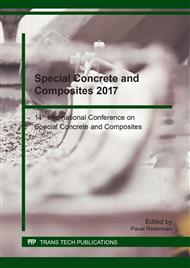[1]
J. Plank, Applications of biopolymers and other biotechnological products in building materials, Appl. Microbiol. Biotechnol. 66 (2004) 1–9.
DOI: 10.1007/s00253-004-1714-3
Google Scholar
[2]
F. Pacheco-Torgal, V. Ivanov, N. Karak, H. Jonkers, Biopolymers and Biotech Admixtures for Eco-Efficient Construction Materials, Woodhead Publishing, Duxford, (2016).
DOI: 10.1016/b978-0-08-100214-8.00001-4
Google Scholar
[3]
R.A. Gross, C. Scholz, Biopolymers from Polysaccharides and Agroproteins, American Chemical Society. ACS Symposium Series No. 786, (2001).
DOI: 10.1021/bk-2001-0786
Google Scholar
[4]
H. Zhang, J. Zhou, Y. Zhou, Y. Zhang, Research and application of carboxymethyl hydroxypropyl guar (CMHPG) fracturing fluid, Complex Hydrocarbon Reservoirs, 2 (2013).
Google Scholar
[5]
M. Cappellari, A. Daubresse, M. Chaouche, Influence of organic thickening admixtures on the rheological properties of mortars: relationship with water-retention, Constr. Build. Mater. 38 (2013) 950–961.
DOI: 10.1016/j.conbuildmat.2012.09.055
Google Scholar
[6]
T. Pinot, A. Govin, P. Grosseau, Impact of hydroxypropylguars on the early age hydration of Portland cement, Cem. Concr. Res. 44 (2013) 69–76.
DOI: 10.1016/j.cemconres.2012.10.010
Google Scholar
[7]
T. Pinot, A. Govin, P. Grosseau, Importance of coil-overlapping for the effectiveness of hydroxypropylguars as water retention agent in cement-based mortars, Cem. Concr. Res. 56 (2014) 61–68.
DOI: 10.1016/j.cemconres.2013.11.005
Google Scholar
[8]
T. Pinot, A. Govin, P. Grosseau, Influence of hydroxypropylguars on rheological behavior of cement-based mortars, Cem. Concr. Res. 58 (2014) 161–168.
DOI: 10.1016/j.cemconres.2014.01.020
Google Scholar
[9]
A. Govin, M-C. Bartholin, B. Biasotti, M. Giudici, V. Langella, P. Grosseau, Modification of water retention and rheological properties of fresh state cement-based mortars by guar gum derivatives, Constr. Build. Mater. 122 (2016) 772–780.
DOI: 10.1016/j.conbuildmat.2016.06.125
Google Scholar
[10]
A. Izaguirre, J. Lanas, J.I. Álvarez, Ageing of lime mortars with admixtures: Durability and strength assessment, Cem. Concr. Res. 40 (2010) 1081–1095.
DOI: 10.1016/j.cemconres.2010.02.013
Google Scholar
[11]
A. Izaguirre, J. Lanas, J.I. Álvarez, Characterization of aerial lime-based mortars modified by the addition of two different water-retaining agents, Cem. Concr. Comp. 33 (2011) 309–318.
DOI: 10.1016/j.cemconcomp.2010.09.008
Google Scholar
[12]
D. Szopinski, G.A. Luinstra, Viscoelastic properties of aqueous guar gum derivative solutions under large amplitude oscillatory shear (LAOS), Carbohydr. Polym. 153 (2016) 312–319.
DOI: 10.1016/j.carbpol.2016.07.095
Google Scholar
[13]
T.G. Mezger, The Rheology Handbook, 4th ed., Vincentz Network, Hanover, (2014).
Google Scholar
[14]
A Izaguirre, J. Lanas, J.I. Álvarez, Behaviour of a starch as a viscosity modifier for aerial lime-based mortars, Carbohydr. Polym. 80 (2009) 222–228.
DOI: 10.1016/j.carbpol.2009.11.010
Google Scholar
[15]
M. Vyšvařil, T. Žižlavský, Effect of chitosan ethers on fresh state properties of lime mortars, submitted to Journal of Physics: Conference Series (2017).
DOI: 10.1088/1757-899x/251/1/012039
Google Scholar
[16]
M.P. Seabra, H. Paiva, J.A. Labrincha, V.M. Ferreira, Admixtures effect on fresh state properties of aerial lime based mortars, Constr. Build. Mater. 23 (2009) 1147–1153.
DOI: 10.1016/j.conbuildmat.2008.06.008
Google Scholar
[17]
T. Pinot, M. -C. Bartholin, A. Govin, P. Grosseau, Influence of the polysaccharide addition method on the properties of fresh mortars, Cem. Concr. Res. 70 (2015) 50–59.
DOI: 10.1016/j.cemconres.2015.01.004
Google Scholar


